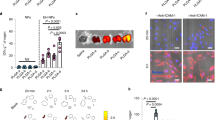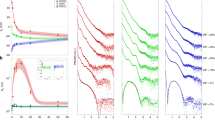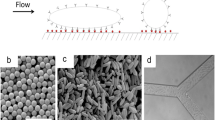Abstract
The rapid elimination of nanoparticles from the bloodstream by the mononuclear phagocyte system limits the activity of many nanoparticle formulations. Here, we show that inducing a slight and transient depletion of erythrocytes in mice (~5% decrease in haematocrit) by administrating a low dose (1.25 mg kg−1) of allogeneic anti-erythrocyte antibodies increases the circulation half-life of a range of short-circulating and long-circulating nanoparticle formulations by up to 32-fold. Treatment of the animals with anti-erythrocyte antibodies significantly improved the targeting of CD4+ cells in vivo with fluorescent anti-CD4-antibody-conjugated nanoparticles, the magnetically guided delivery of ferrofluid nanoparticles to subcutaneous tumour allografts and xenografts, and the treatment of subcutaneous tumour allografts with magnetically guided liposomes loaded with doxorubicin and magnetite or with clinically approved ‘stealthy’ doxorubicin liposomes. The transient and partial blocking of the mononuclear phagocyte system may enhance the performance of a wide variety of nanoparticle drugs.
This is a preview of subscription content, access via your institution
Access options
Access Nature and 54 other Nature Portfolio journals
Get Nature+, our best-value online-access subscription
$29.99 / 30 days
cancel any time
Subscribe to this journal
Receive 12 digital issues and online access to articles
$99.00 per year
only $8.25 per issue
Buy this article
- Purchase on Springer Link
- Instant access to full article PDF
Prices may be subject to local taxes which are calculated during checkout






Similar content being viewed by others
Data availability
The main data supporting the results in this study are available within the paper and its Supplementary Information. The raw and analysed datasets are too numerous to be readily shared publicly but can be made available from the corresponding author on reasonable request.
References
Cheng, C. J., Tietjen, G. T., Saucier-Sawyer, J. K. & Saltzman, W. M. A holistic approach to targeting disease with polymeric nanoparticles. Nat. Rev. Drug Discov. 14, 239–247 (2015).
Xie, J., Lee, S. & Chen, X. Nanoparticle-based theranostic agents. Adv. Drug. Deliv. Rev. 62, 1064–1079 (2010).
Wilson, D. A., Nolte, R. J. M. & van Hest, J. C. M. Autonomous movement of platinum-loaded stomatocytes. Nat. Chem. 4, 268–274 (2012).
Nikitin, M. P., Shipunova, V. O., Deyev, S. M. & Nikitin, P. I. Biocomputing based on particle disassembly. Nat. Nanotechnol. 9, 716–722 (2014).
Tregubov, A. A., Nikitin, P. I. & Nikitin, M. P. Advanced smart nanomaterials with integrated logic-gating and biocomputing: dawn of theranostic nanorobots. Chem. Rev. 118, 10294–10348 (2018).
Wilhelm, S. et al. Analysis of nanoparticle delivery to tumours. Nat. Rev. Mater. 1, 16014 (2016).
Amoozgar, Z. & Yeo, Y. Recent advances in stealth coating of nanoparticle drug delivery systems. Wiley Interdiscip. Rev. Nanomed. Nanobiotechnol. 4, 219–233 (2012).
Schottler, S. et al. Protein adsorption is required for stealth effect of poly(ethylene glycol)- and poly(phosphoester)-coated nanocarriers. Nat. Nanotechnol. 11, 372–377 (2016).
Hong, R.-L. et al. Direct comparison of liposomal doxorubicin with or without polyethylene glycol coating in C-26 tumor-bearing mice: is surface coating with polyethylene glycol beneficial? Clin. Cancer Res. 5, 3645–3652 (1999).
Salvati, A. et al. Transferrin-functionalized nanoparticles lose their targeting capabilities when a biomolecule corona adsorbs on the surface. Nat. Nanotechnol. 8, 137–143 (2013).
Klibanov, A. L., Maruyama, K., Beckerleg, A. M., Torchilin, V. P. & Huang, L. Activity of amphipathic poly(ethylene glycol) 5000 to prolong the circulation time of liposomes depends on the liposome size and is unfavorable for immunoliposome binding to target. Biochim. Biophys. Acta 1062, 142–148 (1991).
Turk, M. J., Waters, D. J. & Low, P. S. Folate-conjugated liposomes preferentially target macrophages associated with ovarian carcinoma. Cancer Lett. 213, 165–172 (2004).
Abu Lila, A. S., Kiwada, H. & Ishida, T. The accelerated blood clearance (ABC) phenomenon: clinical challenge and approaches to manage. J. Control. Release 172, 38–47 (2013).
Lin, H., Chen, Y. & Shi, J. Nanoparticle-triggered in situ catalytic chemical reactions for tumour-specific therapy. Chem. Soc. Rev. 47, 1938–1958 (2018).
Cherkasov, V. R. et al. Nanoparticle beacons: supersensitive smart materials with on/off-switchable affinity to biomedical targets. ACS Nano 14, 1792–1803 (2020).
Villa, C. H. et al. Delivery of drugs bound to erythrocytes: new avenues for an old intravascular carrier. Ther. Deliv. 6, 795–826 (2015).
Zaitsev, S. et al. Targeting recombinant thrombomodulin fusion protein to red blood cells provides multifaceted thromboprophylaxis. Blood 119, 4779–4785 (2012).
Zelepukin, I. V. et al. Nanoparticle-based drug delivery via RBC-hitchhiking for the inhibition of lung metastases growth. Nanoscale 11, 1636–1646 (2019).
Brenner, J. S. et al. Red blood cell-hitchhiking boosts delivery of nanocarriers to chosen organs by orders of magnitude. Nat. Commun. 9, 2684 (2018).
Chambers, E. & Mitragotri, S. Prolonged circulation of large polymeric nanoparticles by non-covalent adsorption on erythrocytes. J. Control. Release 100, 111–119 (2004).
van Rooijen, N. & Sanders, A. Liposome-mediated depletion of macrophages—mechanism of action, preparation of liposomes and applications. J. Immunol. Methods 174, 83–93 (1994).
Tavares, A. J. et al. Effect of removing Kupffer cells on nanoparticle tumor delivery. Proc. Natl Acad. Sci. USA 114, E10871–E10880 (2017).
Hardonk, M. J., Dijkhuis, F. W., Hulstaert, C. E. & Koudstaal, J. Heterogeneity of rat liver and spleen macrophages in gadolinium chloride-induced elimination and repopulation. J. Leukoc. Biol. 52, 296–302 (1992).
Lazar, G. The reticuloendothelial-blocking effect of rare earth metals in rats. J. Reticuloendothel. Soc. 13, 231–237 (1973).
Murray, I. M. The mechanism of blockade of the reticuloendothelial system. J. Exp. Med. 117, 139–147 (1963).
Kao, Y. J. & Juliano, R. L. Interactions of liposomes with the reticuloendothelial system effects of reticuloendothelial blockade on the clearance of large unilamellar vesicles. Biochim. Biophys. Acta 677, 453–461 (1981).
Souhami, R. L. & Bradfield, J. W. B. The recovery of hepatic phagocytosis after blockade of Kupffer cells. J. Reticuloendothel. Soc. 16, 75–86 (1974).
Souhami, R. L., Patel, H. M. & Ryman, B. E. The effect of reticuloendothelial blockade on the blood clearance and tissue distribution of liposomes. Biochim. Biophys. Acta 674, 354–371 (1981).
Di Luzio, N. R. & Wooles, W. R. Depression of phagocytic activity and immune response by methyl palmitate. Am. J. Physiol. 206, 939–943 (1964).
Proffitt, R. et al. Liposomal blockade of the reticuloendothelial system: improved tumor imaging with small unilamellar vesicles. Science 220, 502–505 (1983).
Liu, D., Mori, A. & Huang, L. Role of liposome size and RES blockade in controlling biodistribution and tumor uptake of GM1-containing liposomes. Biochim. Biophys. Acta 1104, 95–101 (1992).
Liu, T., Choi, H., Zhou, R. & Chen, I.-W. RES blockade: a strategy for boosting efficiency of nanoparticle drug. Nano Today 10, 11–21 (2015).
Sun, X. et al. Improved tumor uptake by optimizing liposome based RES blockade strategy. Theranostics 7, 319–328 (2017).
Liu, L. et al. Decreased reticuloendothelial system clearance and increased blood half-life and immune cell labeling for nano- and micron-sized superparamagnetic iron-oxide particles upon pre-treatment with Intralipid. Biochim. Biophys. Acta 1830, 3447–3453 (2013).
Shibata, T. et al. Monoclonal anti-erythrocyte autoantibodies derived from NZB mice cause autoimmune hemolytic anemia by two distinct pathogenic mechanisms. Int. Immunol. 2, 1133–1141 (1990).
Fossati-Jimack, L. et al. High pathogenic potential of low-affinity autoantibodies in experimental autoimmune hemolytic anemia. J. Exp. Med. 190, 1689–1696 (1999).
Baudino, L. et al. Differential contribution of three activating IgG Fc receptors (Fc RI, Fc RIII, and Fc RIV) to IgG2a- and IgG2b-induced autoimmune hemolytic anemia in mice. J. Immunol. 180, 1948–1953 (2008).
da Silveira, S. A. et al. Complement activation selectively potentiates the pathogenicity of the IgG2b and IgG3 isotypes of a high affinity anti-erythrocyte autoantibody. J. Exp. Med. 195, 665–672 (2002).
Syed, S. N. et al. C5aR activation in the absence of C5a: a new disease mechanism of autoimmune hemolytic anemia in mice. Eur. J. Immunol. 48, 696–704 (2018).
Nikitin, P. I. & Vetoshko, P. M. Process of analysis of mixture of biological and/or chemical components with use of magnetic particles and device for its implementation. Russian patent RU2166751 (2000).
Nikitin, P. I., Vetoshko, P. M. & Ksenevich, T. I. New type of biosensor based on magnetic nanoparticle detection. J. Magn. Magn. Mater. 311, 445–449 (2007).
Nikitin, M. P., Torno, M., Chen, H., Rosengart, A. & Nikitin, P. I. Quantitative real-time in vivo detection of magnetic nanoparticles by their nonlinear magnetization. J. Appl. Phys. 103, 07A304 (2008).
Nikitin, M. P. et al. Ultrasensitive detection enabled by nonlinear magnetization of nanomagnetic labels. Nanoscale 10, 11642–11650 (2018).
Flannagan, R. S., Jaumouille, V. & Grinstein, S. The cell biology of phagocytosis. Annu. Rev. Pathol. 7, 61–98 (2012).
Bertrand, N. & Leroux, J.-C. The journey of a drug-carrier in the body: an anatomo-physiological perspective. J. Control. Release 161, 152–163 (2012).
Tsoi, K. M. et al. Mechanism of hard-nanomaterial clearance by the liver. Nat. Mater. 15, 1212–1221 (2016).
da Silveira, S. A. et al. Complement activation selectively potentiates the pathogenicity of the IgG2b and IgG3 isotypes of a high affinity anti-erythrocyte autoantibody. J. Exp. Med. 195, 665–672 (2002).
Meyer, D. et al. Fc gamma RIII (CD16)-deficient mice show IgG isotype-dependent protection to experimental autoimmune hemolytic anemia. Blood 92, 3997–4002 (1998).
Haakenstad, A. O. & Mannik, M. Saturation of the reticuloendothelial system with soluble immune complexes. J. Immunol. 112, 1939–1948 (1974).
Siragam, V. et al. Can antibodies with specificity for soluble antigens mimic the therapeutic effects of intravenous IgG in the treatment of autoimmune disease? J. Clin. Invest. 115, 155–160 (2005).
Semple, J. W. et al. Anti-D (WinRho SD) treatment of children with chronic autoimmune thrombocytopenic purpura stimulates transient cytokine/chemokine production. Am. J. Hematol. 69, 225–227 (2002).
Robak, T. et al. Rozrolimupab, a mixture of 25 recombinant human monoclonal RhD antibodies, in the treatment of primary immune thrombocytopenia. Blood 120, 3670–3676 (2012).
Galanzha, E. I. et al. In vivo magnetic enrichment and multiplex photoacoustic detection of circulating tumour cells. Nat. Nanotechnol. 4, 855–860 (2009).
Häfeli, U. O. Magnetically modulated therapeutic systems. Int. J. Pharm. 277, 19–24 (2004).
Al-Jamal, K. T. et al. Magnetic drug targeting: preclinical in vivo studies, mathematical modeling, and extrapolation to humans. Nano Lett. 16, 5652–5660 (2016).
Liang, P.-C. et al. Doxorubicin-modified magnetic nanoparticles as a drug delivery system for magnetic resonance imaging-monitoring magnet-enhancing tumor chemotherapy. Int. J. Nanomed. 11, 2021–2037 (2016).
Rodriguez, P. L. et al. Minimal “self” peptides that inhibit phagocytic clearance and enhance delivery of nanoparticles. Science 339, 971–975 (2013).
Crow, A. R. & Lazarus, A. H. The mechanisms of action of intravenous immunoglobulin and polyclonal anti-D immunoglobulin in the amelioration of immune thrombocytopenic purpura: what do we really know? Transfus. Med. Rev. 22, 103–116 (2008).
Lazarus, A. H. Monoclonal versus polyclonal anti-D in the treatment of ITP. Expert Opin. Biol. Ther. 13, 1353–1356 (2013).
Villa, C. H., Seghatchian, J. & Muzykantov, V. Drug delivery by erythrocytes: “Primum non nocere”. Transfus. Apher. Sci. 55, 275–280 (2016).
Khoory, J. et al. Ligation of glycophorin A generates reactive oxygen species leading to decreased red blood cell function. PLoS ONE 11, e0141206 (2016).
Ryder, A. B., Zimring, J. C. & Hendrickson, J. E. Factors influencing rbc alloimmunization: lessons learned from murine models. Transfus. Med. Hemother. 41, 406–419 (2014).
Kontos, S., Kourtis, I. C., Dane, K. Y. & Hubbell, J. A. Engineering antigens for in situ erythrocyte binding induces T-cell deletion. Proc. Natl Acad. Sci. USA 110, E60–E68 (2013).
Szebeni, J. Complement activation-related pseudoallergy: a stress reaction in blood triggered by nanomedicines and biologicals. Mol. Immunol. 61, 163–173 (2014).
Muzykantov, V. R., Smirnov, M. D. & Klibanov, A. L. Avidin attachment to red blood cells via a phospholipid derivative of biotin provides complement-resistant immunoerythrocytes. J. Immunol. Methods 158, 183–190 (1993).
Bratosin, D. et al. Cellular and molecular mechanisms of senescent erythrocyte phagocytosis by macrophages. A review. Biochimie 80, 173–195 (1998).
van Dijk, H., Rademaker, P. M. & Willers, J. M. Estimation of classical pathway of mouse complement activity by use of sensitized rabbit erythrocytes. J. Immunol. Methods 39, 257–268 (1980).
Acknowledgements
We thank A. F. Topolskov (General Physics Institute, RAS) for engineering assistance; O. A. Kharlova (Diagnostic Centre 6 of Moscow Health Department) and A. В. Schekhter (First Moscow State Medical University) for help with histology; A. M. Sapozhnikov (Institute of Bioorganic Chemistry, RAS) for access to and help with FACScan; and R. I. Yakubovskaya (Moscow Oncology Research Centre) for supplying B16-F1 and LLC cell lines and support with establishing the mouse tumour model. Certain aspects of this multidisciplinary research were partially supported by the Russian Science Foundation grants 16-19-00131 (in vitro phagocytosis study; histology; toxicity and complement studies), 16-12-10543 (development of the MPQ measurement methodology and related detectors; MRI particle biodistribution study) and 17-74-20146 (inflammation study; nanoparticle characterization; RBC biodistribution study).
Author information
Authors and Affiliations
Contributions
M.P.N. conceived the idea, designed the study and supervised the project. I.V.Z. performed all of the in vivo experiments, the toxicity study, and nanoparticle synthesis and characterization. M.P.N. and P.I.N. developed and optimized the MPQ-based technique for nanoparticle circulation measurements. V.O.S. performed all of the in vitro experiments and the cytokine and sepsis studies. I.L.S. performed in vitro phagocytosis studies and MPS-cytoblockade in rats, and co-performed toxicity experiments. M.P.N. co-performed the MRI measurements, in vitro phagocytosis studies and developed doxorubicin–magnetite liposomes. M.P.N., I.V.Z., S.M.D. and P.I.N. analysed data. M.P.N. and P.I.N. wrote the manuscript.
Corresponding author
Ethics declarations
Competing interests
M.P.N., I.V.Z., S.M.D. and P.I.N. are inventors on patent applications (RU2014145276 and PCT/RU2015/000755) and a patent (RU2683020) related to the findings described in this manuscript. P.I.N. is a named inventor on MPQ-related patents (RU2166751 and RU2177611).
Additional information
Publisher’s note Springer Nature remains neutral with regard to jurisdictional claims in published maps and institutional affiliations.
Supplementary information
Supplementary information
Supplementary figures, tables and notes.
Rights and permissions
About this article
Cite this article
Nikitin, M.P., Zelepukin, I.V., Shipunova, V.O. et al. Enhancement of the blood-circulation time and performance of nanomedicines via the forced clearance of erythrocytes. Nat Biomed Eng 4, 717–731 (2020). https://doi.org/10.1038/s41551-020-0581-2
Received:
Accepted:
Published:
Issue Date:
DOI: https://doi.org/10.1038/s41551-020-0581-2



